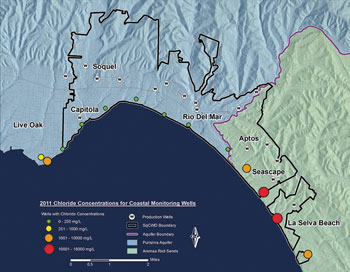By Noel Smith

According to Melanie Schumacher, scwd2 Public Outreach Coordinator, “Even rationing costs money. In order to get people to reduce usage there will be rebate programs for more water efficient technology, which includes not just in-home appliances but also replanting lawns and gardens with drought resistant foliage.
Rates will go up because the more water is saved, the more each unit of water used costs because we still have to maintain and improve the infrastructure; that is the pipes, pumps, water treatment and storage facilities.”
In order to save enough water without additional sources, SqCWD customers would have to reduce their water usage by 35 percent for the next 20 years according to the district. That also means that a moratorium on addition water usage (i.e. no new customers or significant increases by current customers) would have to be put into effect at some time.
“As of January 1 we have gone to monthly billing,” said Adamson, “This helps keep more timely track of water usage for our customers to catch any problems. Our tiered rates encourage our customers to use less water while those who use more, pay more for their water. Unfortunately, people normally use more water during a drought. To reduce water usage and to recharge the aquifer, we need rain.”
Adamson, said, “The district uses just half of the water currently being pumped out of these aquifers. Private well owners are using the other half, which includes Cabrillo College and Seascape Golf Course. We have invited about 40 of the larger private well owners to a meeting to discuss the situation we all find ourselves in – that of how to reduce usage and discuss what other alternatives we have.”
After years of overdrafting by both public and private water users of the aquifers that provide water for the mid-county, the district has been trying to find a supplemental supply so they could reduce pumping and allow the aquifers to be recharged. Desalination seemed to be the answer in partnership with the Santa Cruz Water Department (SCWD).
The plan was for the SCWD to use desal water during the dry part of the year and for the SqCWD to use water to supplement their supply so they could reduce pumping water from the aquifers. Then came the outcry against desal water in the city of Santa Cruz and the removal of the desal plan from serious consideration for the immediate future.
Now that a desal plant run in partnership with the city of Santa Cruz seems a dead issue, what other supplemental supplies seem possible?
The district is holding a series of meetings to inform the public on what alternatives they have. The first meeting covered the issue of getting water from another desal water provider or building its own desal facility.
The second meeting discussed water transfers from the SCWD but this seems impractical in light of the current drought and the federal government’s concern that stream flows be kept larger to promote salmon and steelhead population growth.
The fourth meeting will be at 7 p.m. on February 4 in the Capitola City Council Chambers 420 Capitola Avenue and will consider the subject of recycling water. Currently the state does not allow recycling water for human consumption but according to Schumacher, the technology is similar to desalination but doesn’t require as much energy as the desal process does. And with all of California experiencing drought conditions, the rules may change to allow using recycled water as a supplemental water supply.
As the need for water will not go away and the drought continues, the water crisis is definitely here.